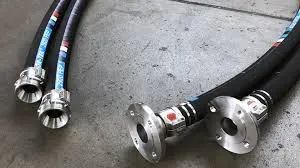In this world of manufacturing, precision and reliability are paramount. The rubber hose industry is a testament to the crucial role of quality standards. These unassuming components are taken for granted. They are integral to a wide range of applications. These range from automotive systems to industrial machinery. Ensuring the quality of rubber hoses goes a long way in ensuring safety.
Rubber Hose Industry Overview
The Rubber Hose Industry is vital in many areas, providing flexible solutions for moving liquids and materials. This overview explores where rubber hoses are used, like in cars, factories, farms, and construction. Rubber hoses are crucial for making sure liquids and gases can move smoothly in these different industries.
Recently, the Rubber Hose Industry has seen improvements in materials and how hoses are made. These changes make rubber hoses last longer, perform better, and meet safety standards, making them reliable in many industrial processes.
Picking the right rubber hose means thinking about things like what materials it will touch, how much pressure it can handle, and if it can handle high or low temperatures. This overview is a helpful guide for businesses and professionals looking for information on choosing the right rubber hoses for their specific needs.
As a key part of systems that move fluids, the Rubber Hose Industry keeps changing to meet the needs of modern industries. Understanding where rubber hoses are used, the improvements happening, and what to consider when picking them helps businesses and professionals make smart choices for their industrial processes.
Innovations Driving the Rubber Hose Industry Forward
The rubber hose industry is changing a lot because of new ideas that are making it better. Technology is a big part, of making hoses work better in different jobs. They now use special rubber that can handle tough conditions, chemicals, and hot or cold temperatures.
This keeps the hoses strong and working well in many industries. They also use stronger materials like synthetic fibers and tough polymers to make hoses more flexible and durable.
Making hoses is getting smarter too. Machines do more of the work, making the hoses the same quality every time and taking less time to make. This helps companies save money and gives customers better products.
People are also thinking about the environment. They are making rubber and hoses in ways that are better for the planet. This includes using eco-friendly materials and processes that fit with global efforts for a cleaner world.
In simple words, the rubber hose industry is getting better because of new ideas and materials. Technology and smarter ways of making things are making hoses stronger, more reliable, and good for the environment.
Choosing the Right Rubber Hose
Choosing the right rubber hose is crucial for safety and good performance. Understand your industry’s requirements, such as the type of liquid, pressure, temperature, and intended usage. Check the hose material too; different rubbers resist chemicals, wear, and heat differently. Consider the manufacturing and assess whether the hose possesses the required flexibility and strength for your job.
Make sure the hose meets safety standards and rules for your industry. Also, think about how much care it needs and how long it will last. Considering all these things helps businesses choose the best rubber hose, making sure it works well, lasts long, and keeps everyone safe.
The Ubiquitous Rubber Hose
Rubber hoses are, indeed, ubiquitous. They are the uncelebrated workhorses of various industries. They transport liquids and gases with little fanfare. For instance, a car’s radiator hose ensures the engine is at the right temperature. The hydraulic hoses on heavy machinery transfer power and maintain stability. These unsung heroes come in diverse shapes and sizes. They are crafted for specific applications.
The Vital Role of Manufacturing Standards
Manufacturing standards are essential in the rubber hose industry. They serve as a compass to ensure the products meet required specifications and are safe for use. These standards cover material composition, construction, dimensions, and performance characteristics. They are crucial for guaranteeing the hoses’ longevity and the safety of those who rely on them.
Material Matters
The first aspect of manufacturing standards pertains to the choice of materials. Rubber hoses are composed of a mixture of synthetic rubber and reinforcing materials. The type and quality of these components influence the hose’s durability and performance. The most used rubbers include nitrile rubber (NBR), EPDM, and silicone.
Manufacturing standards outline the acceptable tolerances for material properties. These standards specify the ideal composition, including the percentage of rubber. Additives and reinforcement materials are also defined. It ensures the rubber hose is flexible and robust. This helps it to handle the intended application without failure.
Structural Integrity
The construction of a rubber hose is essential. The hose’s design, layering, and reinforcement materials. These play a vital role in determining its resistance to external forces. It is crucial to ensure the hose withstands the pressure it will encounter.
Testing Procedures
Quality standards are for specifying what should be used. They also verify that the product meets those specifications. Rigorous testing procedures are an integral part of rubber hose manufacturing. These tests help identify any material flaws before the hoses are used. Some standard tests include:
Burst Testing
Burst testing uates a hose’s ability to withstand high pressure. The hose is filled with a liquid, and the pressure is increased until the hose bursts. It ensures that the hose contains the fluid under the specified working conditions.
Impulse Testing
Impulse testing simulates the repeated pressure cycles a hose might experience during operation. It assesses the hose’s ability to withstand the stress of continuous expansion. It is essential for hoses used in heavy machinery.
Vacuum Testing
Vacuum testing checks a hose’s ability to maintain its shape and structure. It is crucial in applications where the hose may experience vacuum conditions.
Temperature Testing
Temperature testing assesses how well a hose can perform in extreme temperature conditions. Hoses must remain functional and flexible within a specified temperature range. It is especially critical in applications like automotive cooling systems.
Adherence to Standards
Maintaining quality in the rubber hose industry is adhering to established standards. Organizations set these standards. These organizations develop guidelines for materials, construction, and performance.
More is needed for manufacturers to create products that meet these standards. They must also ensure consistency in production. Quality control measures and regular testing help maintain the integrity of the products.
The Importance of Adherence to Standards
Ensuring the quality of rubber hoses standards is about fulfilling regulatory requirements. Here are a few reasons why adherence to standards is of paramount importance:
Safety
Safety is a non-negotiable priority in any industry. When it comes to rubber hoses, the consequences of failure can be severe. For instance, a hydraulic hose on heavy machinery fails under pressure. It can lead to catastrophic accidents. Adherence to standards ensures that hoses can withstand the stresses. Hence, it reduces the risk of accidents and injuries.
Cost Efficiency
Maintaining strict quality standards in the manufacturing process is costly. Though, it is a cost-effective choice in the long run. High-quality hoses that meet the standards are less likely to fail. It saves time and money, making it a wise investment for businesses.
Environmental Responsibility
Manufacturers must also consider the environmental impact of their products. It involves using materials and manufacturing processes that are environmentally friendly. It reduces the ecological footprint of the industry.
Reputation
A company’s reputation controls the quality of its products. Adhering to standards and delivering high-quality rubber hoses builds trust with customers. A strong reputation can lead to more business opportunities and long-term success.
Conclusion
Manufacturing Standards in the Rubber Hose Industry are vital. Understanding the importance of quality in the rubber hose sector is essential. Take a moment to delve into the manufacturing standards that drive excellence. Choosing the proper hose is critical for performance and safety. Ignoring industry standards can lead to subpar results and potential risks. To learn more on this, we are the best. Visit us.
The rubber hose industry may not be in the limelight, but its role in various sectors is undeniable. The quality of rubber hoses is crucial for safety, reliability, and cost-effectiveness. Manufacturing standards are pivotal in ensuring that hoses meet the required criteria.
Keeping to these standards is a matter of compliance. It’s also a commitment to delivering trusted products. Construction or manufacturing rubber hoses are essential components, and their quality is non-negotiable.
Consumers, businesses, and industries continue to demand higher performance and safety standards. The rubber hose industry must adapt and evolve to meet these demands. The future holds exciting possibilities for ensuring quality standards.
FAQs
Rubber hoses are versatile and used in various industries for tasks like transporting liquids, gases, or materials, as well as in automotive and industrial machinery.
To meet your application’s demands, choose a rubber hose by considering factors like the conveyed material, pressure requirements, temperature range, and environmental conditions.
Rubber hoses, made from different compounds, offer varying resistance to chemicals, abrasion, and extreme temperatures, ensuring compatibility with specific applications.
It’s important to ensure that the chosen rubber hose complies with industry standards and certifications to guarantee safety and regulatory compliance in various applications.
Regular maintenance, proper storage, and following the manufacturer’s guidelines contribute to extending the lifespan of a rubber hose, ensuring long-term cost-effectiveness and performance.

